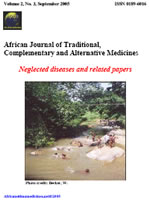
|
African Journal of Traditional, Complementary and Alternative Medicines
African Ethnomedicines Network
ISSN: 0189-6016
Vol. 14, No. 1, 2017, pp. 219-230
|
 Bioline Code: tc17024
Bioline Code: tc17024
Full paper language: English
Document type: Study
Document available free of charge
|
|
|
African Journal of Traditional, Complementary and Alternative Medicines, Vol. 14, No. 1, 2017, pp. 219-230
| en |
ISOLATION OF NOVEL PARA-PENTYL PHENYL BENZOATE FROM MONDIA WHITEI.  (HOOK.F.) SKEELS (PERIPLOCACEAE), ITS STRUCTURE, SYNTHESIS AND NEUROPHARMACOLOGICAL EVALUATION. (HOOK.F.) SKEELS (PERIPLOCACEAE), ITS STRUCTURE, SYNTHESIS AND NEUROPHARMACOLOGICAL EVALUATION.
Taiwo, Bamigboye J.; Osasan, Josephine Y.; Olubiyi, Olujide O.; Oyemitan, Idris A.; Atoyebi Shakir, AM.; Elsegood, Mark R.J. & Jones, Raymond C.F.
Abstract
Background: Mondia whitei L. (Hook. F.) Skeels (Periplocaceae) is a medicinal plant used locally in managing pain, fever,
loss of appetite and as aphrodiasc in the South-Western states of Nigeria. However, the fruit is consumed habitually in the
South-Eastern states of Nigeria, leading to speculation that it may possess some central nervous system effect but which has
not been scientifically investigated, hence this study.
Methodology: Fresh fruits of Mondia whitei were collected and identified by a taxonomist. They were chopped into small
pieces and extracted with absolute ethanol. The crude extract was subjected to various chromatographic techniques to
isolate a novel compound whose structure was elucidated from the analysis of the crystal data and by extensive use of
spectroscopy. The structure was confirmed by synthesis. The compound was subjected to anxiolytic and sedative activity
assay. Computational analysis of the receptor binding event of isolated compound at the gamma amino butyric acid A
receptor was also evaluated.
Results: The structure of the compound was elucidated as para pentyl phenyl benzoate. The neuropharmacological
evaluation of the compound indicated significant (p<0.05) depression of the central nervous system. The binding
characteristics of the compound to gamma amino butyric acid A receptors appears to be more favorable than those obtained
for gamma amino butyric acid, chlorpromazine, benzamidine, and is comparable with the affinity obtained for
pentobarbitone and diazepam.
Conclusion These present data provide evidence for the role of para pentyl phenyl benzoate in the habitual consumption of
the fruit as well as its central nervous system activities.
Keywords
Mondia whitei; Periplocaceae; isolation and synthesis; sedative and anxiolytic effect and Para pentylphenyl benzoate
|
| |
© Copyright [2017] - African Journal of Traditional, Complementary and Alternative Medicines
Alternative site location: http://journals.sfu.ca/africanem/index.php/ajtcam
|
|
